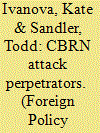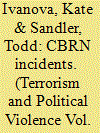|
|
|
Sort Order |
|
|
|
Items / Page
|
|
|
|
|
|
|
| Srl | Item |
| 1 |
ID:
080147


|
|
|
|
|
| Publication |
2007.
|
| Summary/Abstract |
Based on zero-inflated negative binomial regressions applied to the Monterey weapons of mass destruction data, this article assesses the future risks from chemical, biological, radiological, and nuclear (CBRN) terrorism. Once the threshold for CBRN attacks is surpassed, further attacks arise: the expected number of CBRN incidents is over one and a half times higher than past events. Religious cults and groups with a transnational orientation pose the largest CBRN threat to society. Other things constant, nationalists/separatists and religious fundamentalists are not more apt to engage in CBRN terrorism than compared to "other groups." Democratic and corrupt regimes are the likely venues for CBRN incidents. Based on past incidents, rich countries are especially vulnerable to CBRN terrorism. Thus, recent actions by the U.S. Department of Homeland Security to put more resources into guarding against CBRN attacks appear sound. This study indicates that nonfundamentalist terrorists also present CBRN risks to democracies. From a foreign policy viewpoint, CBRN terrorism is not a problem that rich democratic countries can confront alone, because the terrorists will move to where there is the least vigilance. Our study indicates the likely perpetrators and types of attacks that nations must cooperate to avoid
|
|
|
|
|
|
|
|
|
|
|
|
|
|
|
|
| 2 |
ID:
072986


|
|
|
|
|
| Publication |
2006.
|
| Summary/Abstract |
This article investigates the relationship between regime characteristics and the likelihood of chemical, biological, radiological, and nuclear (CBRN) terrorist incidents. Odds ratios establish that democratic ideals-democratic rule, strong rule of law, and honest regimes-are associated with more CBRN incidents. Failed states may be where some terrorist groups form or take refuge, but these states have not been the venue of choice for CBRN incidents. Religious (cults and fundamentalists) and nationalist/separatist groups are not more likely than others to engage in CBRN attacks. To date, indiscriminate CBRN attacks are as likely as discriminate attacks to cause casualties. Transnational terrorist groups are less adept than others in concealing their acquisition of CBRN substances. For some regressions, democratic rule and strong rule of law are positive determinants of CBRN incidents.
|
|
|
|
|
|
|
|
|
|
|
|
|
|
|
|
|
|
|
|
|